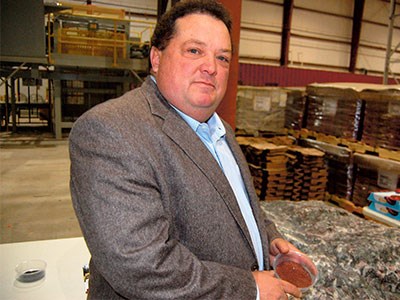A First Nation-owned garnet mining company near Sudbury has launched a major expansion with a new processing plant.
A $4.3-million investment from the Northern Ontario Fund Corp. (NOHFC) will help a Sudbury company become a significant world producer of garnet.
Mohawk Garnet Inc., located in Wahnapitae, northeast of Sudbury, has used funding from the province to build two processing plants – one dry and the other wet – to transform solid garnet into a fine or coarse powder that can be used for abrasive applications.
The investment will create 62 jobs, with the potential for more than 100 jobs by the end of 2014. The jobs will include pit operators, heavy equipment operators, warehouse jobs, millwrights and staff electricians.
Garnet is a mineral that runs between 8.5 and 8.7 on the Mohs hardness scale, said Bob McMurdy, the CEO of Mohawk Garnet.
Diamonds top out the Mohs hardness scale at a 10.
“Because it's very hard and it's very heavy, it works very well as an abrasive,” McMurdy said.
The mineral is primarily used for abrasive blasting applications. Mohawk Garnet operates an open-pit quarry about six kilometres northeast of Wahnapitae. The quarry sits on a 14-kilometre fault line where the garnet runs in veins.
“We're basically following these veins up through the deposit,” McMurdy said.
The company has assayed about 50 per cent of the garnet deposit so far, and has determined the lifetime of the open-pit quarry would be in excess of 100 years at current rates of extraction.
To process the raw material, Mohawk Garnet built a state-of-the-art wet plant near the quarry.
The plant has vertical shaft impact crushers that break the rock into particles smaller than one inch. Those particles then go through a nine-step process in which they are soaked, and the different minerals are separated to isolate the garnet.
“Our wet plant is a closed-loop system,” McMurdy said. “We recycle the water within that plant.”
The plant goes through 8,000 gallons of water every minute. Thanks to the closed-loop system, the water is recycled, instead of being drawn from a lake or creek.
The garnet, which resembles wet sand after it has passed through the wet plant, is then transported to a larger dry plant where it is dried and sorted with a system of conveyor belts and six different screen sizes.
McMurdy said the coarser garnet is most valuable on the world market. The other major garnet deposits – located in western Australia and southern India – are made up of eluvial garnet, which is more fine than Sudbury's solid variety. “They're basically mining old sand bars,” McMurdy said.
The coarser variants are more abrasive, and therefore more useful for industrial applications. McMurdy said about 50 per cent of his product will be for the North American market. But Mohawk Garnet has also received inquiries from the Middle East, Australia and Indonesia. “It's basically a global market,” he said.




